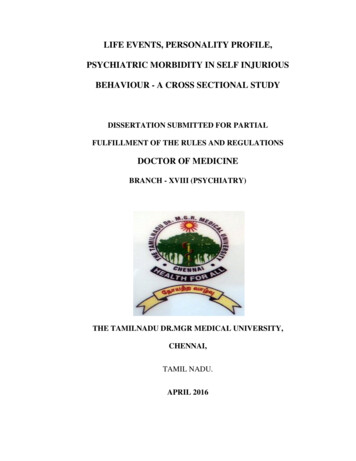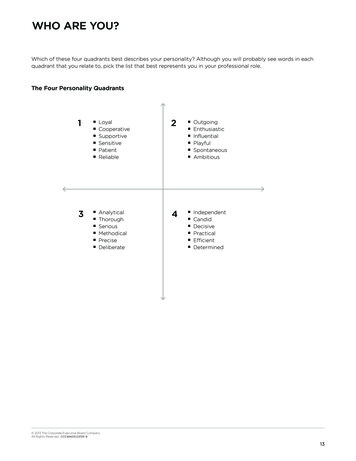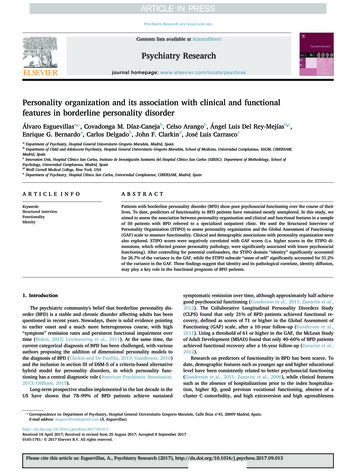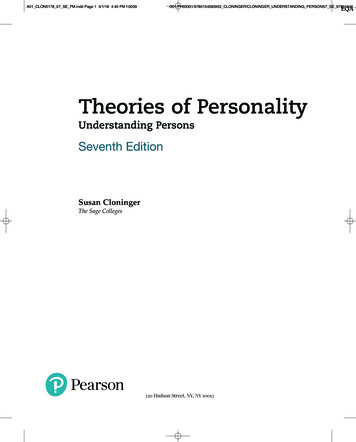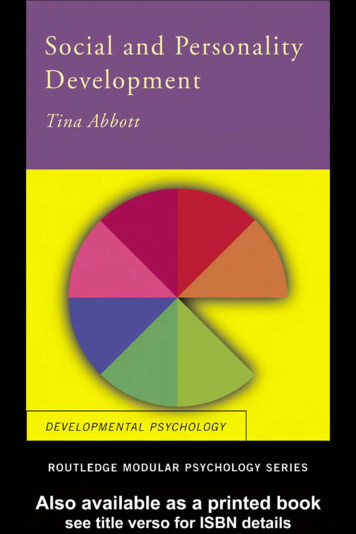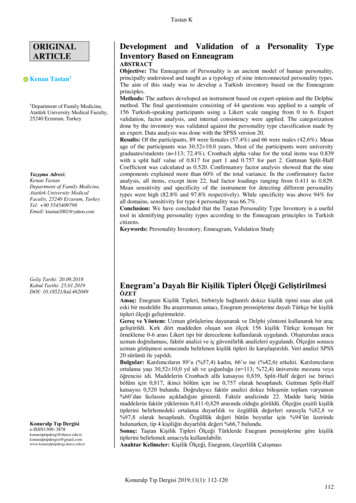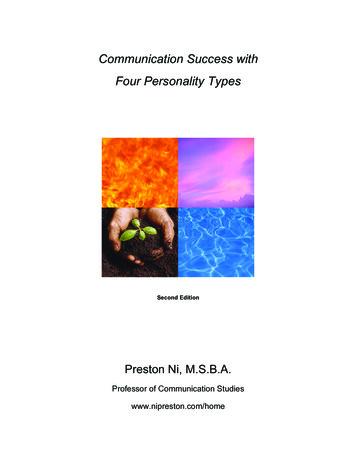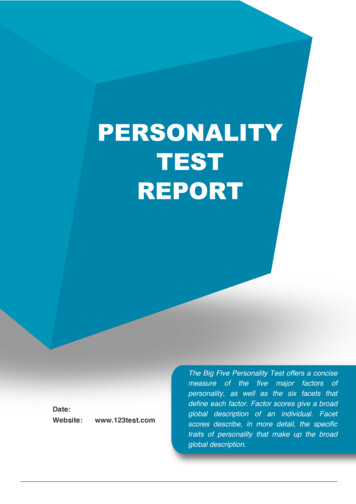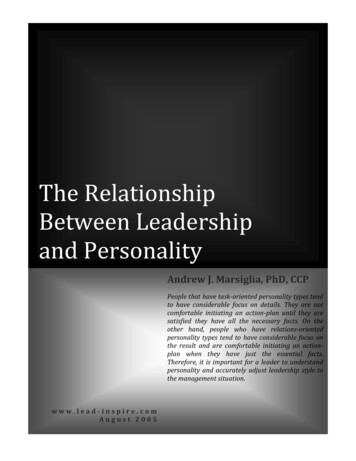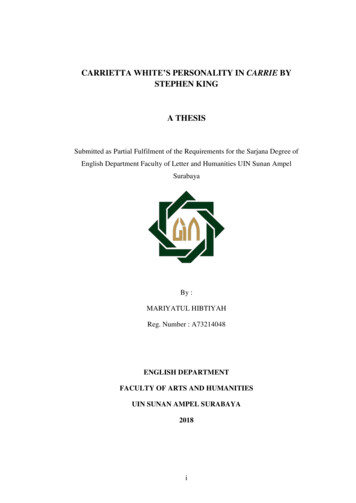
Transcription
CARRIETTA WHITE’S PERSONALITY IN CARRIE BYSTEPHEN KINGA THESISSubmitted as Partial Fulfilment of the Requirements for the Sarjana Degree ofEnglish Department Faculty of Letter and Humanities UIN Sunan AmpelSurabayaBy :MARIYATUL HIBTIYAHReg. Number : A73214048ENGLISH DEPARTMENTFACULTY OF ARTS AND HUMANITIESUIN SUNAN AMPEL SURABAYA2018i
ABSTRACTHibtiyah, Mariyatul 2018. Carrietta White’s Personality in Carrie by StephenKing. Thesis. English Department. Faculty of Arts and Humanities. StateIslamic University of Sunan Ampel surabaya.The Advisor : Sufi Ikrima Sa’adah, M. HumThe thesis focuses on the personality of the main character named Carrie and thefactors that affect her personality. This thesis uses personality theory of Carl Jungthat focuses only on archetypes that includes Persona, Shadow, Anima & Animusand Self to be able to find Carrie's personality. This research uses descriptivequalitative method. The result of the research finds that Carrie's personality isstrongly influenced by her religious fanatical mother and her schoolmates whoalways bully and avoid her, so that Carrie’s personality grow and generate 1)Carrie's persona is quiet and watchful to her friends and obedient to her mother.Persona occur on the basis of the demands of the environment and the peoplearound her. 2) Carrie’s shadow characterized by rebel, anger, revenge, physicalharm and murderous act. Shadow happens because she feels imperfect and toomany bully and mockery she got so she can not see the good side of herself. 3)The animus of Carrie appears in the form of forceful argument. It happensbecause exhaustion and boredom to her life that is always arranged by her mother.4) Self from Carrie through three phases, namely, the first phase, the discoveryphase of the goal of life from three of the previous archetypes to become a normalgirl, the second phase, the phase to actulize that goal but she fails, so that itcreates a new goal for revenge on those who have destroyed her goal, and the lastphase, consciousness phase, Carrie realizes and feels guilty for her revenge. Allthree phases are due to the strong desire of Carrie to turn her life into the life shewanted. Eventually Carrie’s self is unbalanced because she can not actualize hergoal of life.Keywords: Personality, Bully, Archetypesxdigilib.uinsby.ac.id digilib.uinsby.ac.id digilib.uinsby.ac.id digilib.uinsby.ac.id digilib.uinsby.ac.id digilib.uinsby.ac.id digilib.uinsby.ac.id
ABSTRAKHibtiyah, Mariyatul 2018. Carrietta White’s Personality in Carrie by StephenKing. Skripsi. English Department. Faculty of Arts and Humanities. StateIslamic University of Sunan Ampel surabaya.Pembimbing : Sufi Ikrima Sa’adah, M. HumSkripsi fokus pada kepribadian tokoh utama bernama Carrie dan faktor-faktoryang mempengaruhi kepribadian itu muncul pada dirinya. Skripsi inimenggunakan teori kepribadian dari Carl Jung yang hanya terfokus pada arketipeyang mencakup Persona, Shadow, Anima & Animus dan Self untuk dapatmengetahui kepribadian Carrie. Penelitian ini menggunakan metode deskriptifkualitatif. Hasil penelitian menunjukkan bahwa kepribadian Carrie sangatdipengaruhi oleh ibunya yang fanatik terhadap agama dan teman-temansekolahnya yang selalu mem-bully dan menjauhinya, sehingga kepribadian Carrietumbuh dan menghasilkan 1) Persona yang dimiliki Carrie adalah pendiam danwaspada terhadap teman-temannya dan penurut kepada ibunya. Persona terjadiatas dasar tuntutan lingkungan dan orang-orang disekitarnya. 2) Shadow yangdimiliki oleh Carrie ditandai dengan pemberontakan, kemarahan, dendam,menyakiti secara fisik dan pembunuhan. Shadow terjadi karena ia merasa tidaksempurna dan telalu banyak mendapat bully dan ejekkan sehingga dia merasatidak memiliki sisi baik pada dirinya. 3) Animus dari Carrie muncul dalam bentukargumen yang kuat. Itu terjadi karena kelelahan dan kebosanan terhadap hidupnyayang selalu diatur oleh ibunya. 4) Self dari Carrie melalui tiga fase, yakni, fasepertama, fase penemuan tujuan hidup dari ke tiga arketipe sebelumnya untukmenjadi gadis normal, fase kedua, fase untuk mewujudkan tujuan tersebut namungagal sehingga menumbuhkan tujuan baru untuk membalas dendam kepadaorang-orang yang telah merusak tujuannya, dan fase terakhir, fase kesadaran,Carrie sadar dan merasa bersalah atas balas dendam yang dilakukannya. Ketigafase tersebut terjadi akibat adanya keinginan kuat dari Carrie untuk mengubahhidupnya menjadi hidup yang diinginkannya selama ini. Pada akhirnya, self yangdimiliki tidak berjalan seimbang sebab dia tidak dapat mewujudkan keinginannya.Kata kunci : Kepribadian, Bully, Arketipexidigilib.uinsby.ac.id digilib.uinsby.ac.id digilib.uinsby.ac.id digilib.uinsby.ac.id digilib.uinsby.ac.id digilib.uinsby.ac.id digilib.uinsby.ac.id
TABLE OF CONTENTSInside cover page . iInside title page. iiDeclaration page . iiiDedication page . ivMotto . vAdvisor’s approval page . viExaminer’s approval page . viiAcknowledgements . viiiTable of contents . xAbstract . xiiiAbstrak . xivCHAPTER I INTRODUCTION1.1Background of the study . 11.2Statement of the problems. 31.3Objectives of the study . 31.4Significance of the study . 41.5Scope and limitation. 51.6Method of the study . 51.7Definition of key terms . 7CHAPTER II LITERATURE REVIEW2.1Theoretical framework . 82.1.1 Carl Jung’s theory of personality . 8a. Concious (Ego) . 10xiidigilib.uinsby.ac.id digilib.uinsby.ac.id digilib.uinsby.ac.id digilib.uinsby.ac.id digilib.uinsby.ac.id digilib.uinsby.ac.id digilib.uinsby.ac.id
b. Personal unconcious . 10c. Collective unconcious . 11d. Archetypes. 121. Persona . 132. Shadow . 143. Anima & Animus . 15a. Anima . 15b. Animus . 164. Self . 172.2Review of previous study . 19CHAPTER III CARRIETTA WHITE’S PERSONALITY3.I Carrie’s personality based on Carl Jung theory . 233.1.1 Carrie’s persona . 23a. Carrie’s persona in front of her friends . 25b. Carrie’s persona towards her mother . 273.1.2 Carrie’s shadow . 29a. Carrie’s lowest shadow . 301. Rebel . 312. Anger . 313. Revenge . 32b. Carrie’s highest shadow . 331. Physical harm . 342. Murderous Act . 353.1.3 Carrie’s animus . 373.1.4 Carrie’s self . 38a. First phase . 39b. Second phase . 39c. Last phase . 423.2 The factors that affect Carrie’s personality . 443.2.1 The factors of Carrie’s persona . 44xiiidigilib.uinsby.ac.id digilib.uinsby.ac.id digilib.uinsby.ac.id digilib.uinsby.ac.id digilib.uinsby.ac.id digilib.uinsby.ac.id digilib.uinsby.ac.id
a. The factors of Carrie’s persona in front of her friends. 44b. The factors of Carrie’s persona towards her mother . 453.2.2 The factors of Carrie’s shadow . 46a. Lowest shadow . 471. The factors of Carrie’s rebel . 472. The factors of Carrie’s anger. 483. The factors of Carrie’s revenge . 49b. Highest shadow . 501. The factors of Carrie’s physical harm . 502. The factors of Carrie’s murderous act . 513.2.3 The factors of Carrie’s animus . 543.1.4 The factors of Carrie’s self . 56a. The factors of first phase . 56b. The factors of second phase . 57c. The factors of last phase . 58CHAPTER IV CONCLUSION AND SUGGESTION4.1Conclusion . 594.2Suggestion . 62WORK CITED . 63xivdigilib.uinsby.ac.id digilib.uinsby.ac.id digilib.uinsby.ac.id digilib.uinsby.ac.id digilib.uinsby.ac.id digilib.uinsby.ac.id digilib.uinsby.ac.id
Hibtiyah 1CHAPTER IINTRODUCTION1.1Background of the StudyEvery human in this world possesses different personalities even thoughthey live in the same environment, even identical twins have not exactly the samepersonalities. Personality is formed due to family, environmental and socialfactors. It is a pattern of relatively permanent traits and unique characteristics thatgive both consistency and individuality to a person’s behavior. Traits contribute toindividual differences in behavior, consistency of behavior over time, and stabilityof behavior across situations. Traits may be unique, common to some group, orshared by the entire species, but their pattern is different for each individual. Thuseach person, though like others in some ways, has a unique personality (Feist andFeist 4).Personality with a unique and distinct pattern of human traits in eachindividual can be one of the literary studies as Hudson said in his book AnIntroduction to The Study of Literature that literature as an expression ofpersonality because literature is a criticism of life and an interpretation of life(Hudson 14). It means life in literature is closely related to real life. In the real lifethere are human who have personality, it possessed by character that can be foundin a literary work. Character is a distinctive type of person (Abrams 32). In theliterary works, almost all of the characters are created by the author with differenttraits pattern of personalities.digilib.uinsby.ac.id digilib.uinsby.ac.id digilib.uinsby.ac.id digilib.uinsby.ac.id digilib.uinsby.ac.id digilib.uinsby.ac.id digilib.uinsby.ac.id
Hibtiyah 2This research is focused on the personality of a person which can be foundin characters in the novel and this research is interested in studying Carrie novelwhich the main character personality as the focus. It is a horror, epistolary andtragedy novel which written by American author Stephen King, Carrie is the firstnovel which published and one of Stephen King's famous novel. The novel waspublished on April 5 th ,1974 with the first print of about 30,000 copies. Thisnovel made Stephen King become a recognized author in America, as The LosAngeles Times said that Stephen King was a master of storyteller for his novelCarrie, because it can appeal many readers with a unique genre that mixesthrilling horror and science fiction, it also achieves high sales profits in its firstpublication.Two years after its publish, this novel has been adapted into several moviesand musical dramas, such as: The movie, entitled "Carrie" released in 1976,musical broadway entitled "Carrie" staged in 1988 and the west end version in2012, the sequel movie entitled "The Rage: Carrie 2" was released in 1999, atelevision movie entitled "Carrie "Aired in 2002 (Lesnick 1), and a movie withthe same title in 2013, this is a remake of the movie released in 1976 (Neumaiear1). And recently Stephen King has published 50 novels, 200 short stories, fivenon-fiction works, which have been sold over 350 milion copies worldwide(Morgan 1).The novel tells about a young girl Carrietta White and the suddendiscovery of her telekinetic abilities. Carrie has been abused, both physically andemotionally from her religious fanatic mother and her peers at school. One night,digilib.uinsby.ac.id digilib.uinsby.ac.id digilib.uinsby.ac.id digilib.uinsby.ac.id digilib.uinsby.ac.id digilib.uinsby.ac.id digilib.uinsby.ac.id
Hibtiyah 3a terrible tragedy occurs on the night of the school prom, it makes Carrie getangry. She uses her telekinetic power to burn down the entire school and thewhole of Camberlain city until there are many of the victims died. Carrie’s motherwho assumed that Carrie’s body had been overrun by the demons stabs Carrie’sshoulder to kill her, but it makes Carrie’s anger grow wilder. Finally, she kills hermother by stopping her mother’s heart with her telekinetic power, and Carrie diedin the middle of the road because of blood loss.This research applies C.G Jung’s personality theory as the main theory.The analysis focuses on the personality of Carrietta White as the main characterthat is studied by describing her personality based on the contents of thearchetypes which include four aspects (1) Persona, (2) Shadow, (3) Anima andAnimus, and (4) Self, and the factors that affect her personality.1.2Statement of the ProblemsThe research problem consists of main problems that the researcher takesin the context above and this study is arranged to answer the problems formulatedin the following questions :1. How is Carrietta White’s personality potrayed in Stephen King’s novelCarrie ?2. What are the factors that affect Carrietta White’s personality in StephenKing’s novel Carrie ?digilib.uinsby.ac.id digilib.uinsby.ac.id digilib.uinsby.ac.id digilib.uinsby.ac.id digilib.uinsby.ac.id digilib.uinsby.ac.id digilib.uinsby.ac.id
Hibtiyah 41.3Objectives of the StudyBased on the research problems above, the objectives that are purposed toreached are :1. To explain Carrietta White’s personality potrayed in Stephen King’s novelCarrie.2. To describe the factors that affect Carrietta White’s personality in StephenKing’s novel Carrie.1.4Significance of the StudyThe results of this study are expected to serve theoretical and practicalpurposes. Theoretically, for the literary students, this research gives a contributionin literature subject, and it can be a reference or a comparable study in field ofpsychoanalytical literary criticism. This study expects the readers to explore andtake some information, including the novel, the steps how to analyze a novel withthe theory which needed from this study and get more understanding about that.So, this study will be useful to the readers and the academic community (facultyand students).Practically, The common readers are expected to understand that thepersonality can be formed from many factors, whether family, the environment orthe outside world. This study shows how parents have important role in thepersonality development of their children. So, the child’s pesonality will growfrom the original agent, and that is family, because they are the first persons whointeract with them. This research is also expected to show how to respect othersdigilib.uinsby.ac.id digilib.uinsby.ac.id digilib.uinsby.ac.id digilib.uinsby.ac.id digilib.uinsby.ac.id digilib.uinsby.ac.id digilib.uinsby.ac.id
Hibtiyah 5regardless of the family background, and how bully is dangerous to the victim orsuspect, since bully can also cause death.1.5Scope and LimitationThis study discusses the personality of Carrietta White in Carrie novel.This study is focused on C.G.Jung ‘s personality theory discussing about Carrie’spersonality and the factors which affect her personality. The concepts are limitedto the terms of Persona, Shadow, Anima and Animus and Self.1.6Method of the StudyThis part discusses how the data are collected and analyzed. It is dividedinto four sub-chapters, consists of research design, data sources, data collection,and data analysis.1.6.1Research Design.The method used is using a qualitative approach research, the type isdescriptive method, so the data are collected from words to words, paragraph toparagraph and sentence to sentence, to get conclusion. The research containsquotations and focuses on the intrinsic element.1.6.2Data SourcesThe main source of this study is Stephen King’s novel Carrie. The data arein form of any quotes that reflect the personality of Carrietta White and the factorswhich affect her personality.digilib.uinsby.ac.id digilib.uinsby.ac.id digilib.uinsby.ac.id digilib.uinsby.ac.id digilib.uinsby.ac.id digilib.uinsby.ac.id digilib.uinsby.ac.id
Hibtiyah 61.6.3Data CollectionThe data are the most important in research, so data must be collectedeffectively and carefully, the steps of data collecting are as follows:1.6.3.1Reading the novel many times to get best understandingabout the novel1.6.3.2Finding and selecting the data based on the statement ofproblems that are Carrietta White’s personality and thefactors which influence her personality, by underlining theparagraph, sentence, word and quotation in the novel usedred pen for Persona data, green pen for Shadow data, bluepen for Animus data and pink pen for Self data, and usedblack marker to marked the factors which affect herpersonality.1.6.3.3Classifying the data by writing them based on the sequencesof Carrietta White’s personality and the factors which affecther personality in the new note.1.6.4Data AnalysisThe data which have been collected are analyzed using theory ofpersonality. The analysis steps are :1.6.4.1 Identifying Carrietta White’s personality dealing with C.G.Jung theory which include Persona, Shadow, Anima &Animus, and Self.digilib.uinsby.ac.id digilib.uinsby.ac.id digilib.uinsby.ac.id digilib.uinsby.ac.id digilib.uinsby.ac.id digilib.uinsby.ac.id digilib.uinsby.ac.id
Hibtiyah 71.6.4.2 Describing the factors that affect Carrietta White’spersonality.1.6.4.3 Giving the best conclusion based on the analysis.1.7Definition of Key TermsTo avoid any different perceptions between the researcher and the readerin understanding the study, it is essential to give some definition of key termsused in this study. The key terms are :Telekinetic: A term used to refer to a life form capable ofutilizing telekinesis. For example, the minority, whois telekinetic, can move a rock with just his mind. Theminority has great skills with telekinesis. Telekinesisis about moving, stopping, or controlling an object.(Gibson 13)Bullying: Intentionally harmful, aggressive behaviour of amore powerful person or group of people directedrepeatedly toward a less powerful person, usuallywithout provocation. (Harris and Petrie 2)digilib.uinsby.ac.id digilib.uinsby.ac.id digilib.uinsby.ac.id digilib.uinsby.ac.id digilib.uinsby.ac.id digilib.uinsby.ac.id digilib.uinsby.ac.id
Hibtiyah 8CHAPTER IILITERATURE REVIEW2.1Theoretical FrameworkThis chapter discusses about the theoretical explanation about the relatedmaterials and concepts which is suitable with the chosen literary work. The maintheory is personality theory by Carl Gustav Jung to prove Carrieta White’spersonality and the factors which affect her personality.Jung’s theory broke from orthodox psychoanalysis of Freud to establish aseparate theory of personality called analytical psychology, but this theory still apart of psychology study which concentrate on the assumption that hiddenphenomena can and do affect the lives of all people. Jung believed that eachindividual is motivated not only by individual repressed experiences but also bycertain emotionally experiences inherited from the ancestors (Feist and Feist 98).2.1.1 Carl Jung’s Theory of PersonalityThe word “personality” originated from the Latin “ persona”, whichreferred to a theatrical mask worn by Roman actors in Greek dramas. It means amask used by an actor in a performance, or more clearly, an actor in aperformance must be someone else than being himself, but in modern times, manypeople interpret the personality to describe the identity of a person or the firstimpression inflicted someone when they were meeting and seeing each other’sbehavior (Feist and Feist 9).digilib.uinsby.ac.id digilib.uinsby.ac.id digilib.uinsby.ac.id digilib.uinsby.ac.id digilib.uinsby.ac.id digilib.uinsby.ac.id digilib.uinsby.ac.id
Hibtiyah 9Although no single definition is acceptable to all personality theorists, itcan be said that personality is a pattern of relatively permanent traits and uniquecharacteristics that give both consistency and individuality to a person’s behavior(Feist and Feist 4). In the final result, it can be said that the personality focuses onhuman behavior or human behavior in an attempt to align themselves with theenvironment.Carl G. Jung (1875-1961) was a Swiss psychologist whose principles havebeen found to be applicable to nearly all academic disciplines from mythology toreligion to quantum physics, and to nearly all aspects of modern life. In thefollowing selection, Jung discusses his most well-known (and controversial)concept, the collective unconscious, that aspect of the unconscious mind whichmanifests inherited, universal themes which run through all human life. Thecontents of the collective unconscious are archetypes, primordial images thatreflect basic patterns or common to us all, and which have existed universallysince the dawn of time (Jung 99).Jung is known for his personality or psyche theory he used. According toJung's opinion in the book Introduction to Theories Of Personality, personality orpsyche embraces all thought, feeling, and behaviour, conscious and unconcious toadapt with social and physical environment (Hall and Lindzey 109). In Jung’sview, the total personality, or psyche, is composed of several distinct systems orstructures that can influence one another. The major systems are conscious (ego),Personal Unconscious, Collective Unconscious and Archetypes.digilib.uinsby.ac.id digilib.uinsby.ac.id digilib.uinsby.ac.id digilib.uinsby.ac.id digilib.uinsby.ac.id digilib.uinsby.ac.id digilib.uinsby.ac.id
H i b t i y a h 10a. Conscious (Ego)According to Jung’s opinion, conscious images are those that are sensedby the ego (Feist and Feist 103). The ego is the center of consciousness, the partof the psyche concerned with perceiving, thinking, feeling, and remembering. It isan awareness responsible of ourselves for carrying out the normal activities ofwaking life. Ego acts in a selective way, admitting into conscious awareness onlya portion of the stimuli to which it is exposed (Schultz and Schultz 101).For example, a baby learns to distinguish between each individual memberof his family and to distinguish familiar faces from unfamiliar faces. Based onJung's remarks, one resulting from this difference process is the ego. the ego withits consciousness also gives the filter through the filtration process, this is whatthe conscious person can do to distinguish two things from good to bad,corresponding-inappropriate, worthy-not worthy, and so on. A conscious personwill do well in interaction with their environment. The main purpose of thisprocess is for individual to adapt well to their environment.b. Personal UnconsciousThe personal unconscious embraces all repressed, forgotten, orsubliminally perceived experiences of one particular individual. It containsrepressed childhood memories and impulses, forgotten events, and experiencesoriginally perceived below the threshold of our consciousness (Feist and Feist110). Jung said the personal unconscious was the region next to the ego. Itconsists of all the forgotten experiences that have lost their intensity for somereason, possibly because of their unpleasantness. It also includes sensedigilib.uinsby.ac.id digilib.uinsby.ac.id digilib.uinsby.ac.id digilib.uinsby.ac.id digilib.uinsby.ac.id digilib.uinsby.ac.id digilib.uinsby.ac.id
H i b t i y a h 11impressions that are too weak to be perceived consciously (Jung 376). If somepeople unknowingly remember and do things they have done before or things theyhave forgotten, then it is called Personal Unconscious.Contents of the personal unconscious are called complexes. A complex isa core or pattern of experience, emotions, memories, perceptions, and wishes inthe personal unconscious organized around a common theme (Schultz and Schultz104). It means, if someone has ordinary experiences to be forgotten, but theexperience is pressed into personal consciousness, those experiences can beinterconnected to form a complex that has the potential to affect behavior, thiscomplex has the power to color the way someone thinks, feels and acts.c. Collective UnconsciousJung formulates the collective unconscious as a past pictures of the oldgenerations (ancestors), who are reborn in the structure of each individual, itmeans collective unconcious is inherited not individually (Jung 43). In otherwords, it is the storehouse of latent memories of our human and prehumanancestry. It consists of instincts and archetypes that inherit as possibilities and thatoften affect to behaviour. (Ryckman 81). Every people does not realize that thememories are the part of past inheritance and happen naturally.For example, in the Introduction to Theories of Personality, Jung gives anexample of a family environment with a mother figure, because in human lifethere is always a mother's presence, the image of a mother's presence is depictedin our collective unconscious. And this picture, quite apart from our personalexperience of our own mother, this is image or understanding universally.digilib.uinsby.ac.id digilib.uinsby.ac.id digilib.uinsby.ac.id digilib.uinsby.ac.id digilib.uinsby.ac.id digilib.uinsby.ac.id digilib.uinsby.ac.id
H i b t i y a h 12d. ArchetypesArchetypes derives from a Greek compound of arche and tupos. Arche or'first principle' points to the creative source, which cannot be represented or seendirectly. Tupos, or 'impression', refers to any one of the numerous manifestationsof the 'first principle' (De Coster 6)The ancient experiences contained in the collective unconscious aremanifested by recurring themes or patterns Jung called archetypes (Jung, 1947).He also used the term primordial images. There are many such images ofuniversal experiences, as many as there are common human experiences. By beingrepeated in the lives of succeeding generations, archetypes have become imprintedon our psyche and are expressed in our dreams and fantasies (Schultz and Schultz105). For example, a teacher's archetypes are described as a compassionate andkind hearted figure, then that picture will be remembered by their students inevery era continuosly.For example, one of the primary archetypes is the mother–childrelationship, which is characterized by the mother’s protection of the child.Dissolution of this bond must ultimately occur if the person is to attain adulthood.Jung suggested that the bond is broken in many primitive cultures when youngmen undergo rituals of
1). And recently Stephen King has published 50 novels, 200 short stories, five non-fiction works, which have been sold over 350 milion copies worldwide (Morgan 1). The novel tells about a young girl Carrietta White and the sudden discovery of her telekinet

